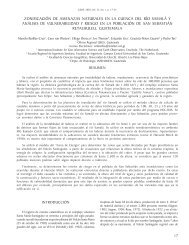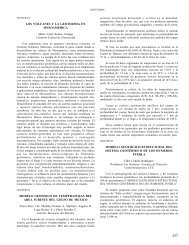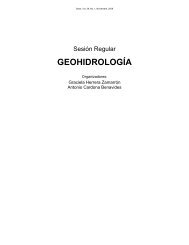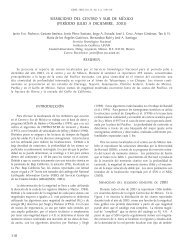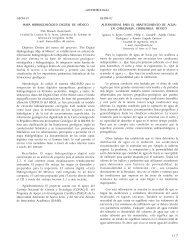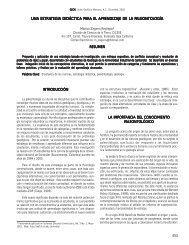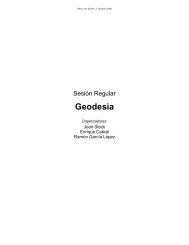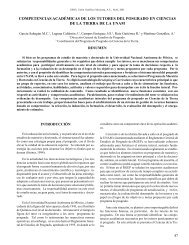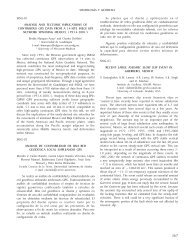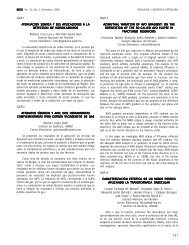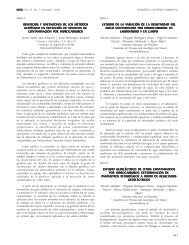GEOMAGNETISMO Y PALEOMAGNETISMO Geos, Vol. 27, No. 1, Octubre, 2007estimates of fairly good quality. Unfortunately, the systematicpresence of coarse multidomain (MD) titanomagnetite in thetransitional and normal polarity flows did not enable us to obtainreliable paleointensities for none of these flows. The Virtual DipoleMoments (VDM) calculated for the reverse polarity flows vary from3.8 to 6.9x10 22 Am2with an arithmetic mean value of 5.5±0.8x 1022 Am2. Thisvalue is i<strong>de</strong>ntical to the mean VDM obtained for the 0.3-5 Matime window and thus strengthens the conclusion that the recentgeomagnetic field strength is anomalously high compared to thatol<strong>de</strong>r than 0.3 Ma. 40Ar/39Ar isochron ages were obtained usingthe incremental heating technique on groundmass separates orphenocryst poor whole rock samples. Six of the transitionallymagnetized lavas yiel<strong>de</strong>d isochron ages that areindistinguishable from one another at the 95% confi<strong>de</strong>nce level.The weighted average age is 862 ± 41 ka. This finding seems tosupport the hypothesis that a geomagnetic excursion has beenrecor<strong>de</strong>d in Tjornes lava flows prior to the Matuyama-Brunhesreversal rather than the actual reversal.GEOPAL-8EARLY CRETACEOUS ABSOLUTEGEOMAGNETIC PALEOINTENSITIESFROM ARAPEY FORMATION (URUGUAY)Cejudo Ruiz Rubén y Gogichaishvili AvtoInstituto <strong>de</strong> Geofísica, UNAMruben@geofisica.unam.mxAbsolute paleointensity <strong>de</strong>terminations before and during CNSare still scarce and of variable qualities. In this study, we reportnew paleointensity data from Arapey Formation (part of theParaná-Eten<strong>de</strong>ka large igneous province) which have severaladvantages: (1) they are wi<strong>de</strong>ly distributed in a large volcanicprovince and easy to access; (2) they record faithfully themagnetic field that existed at the time of their eruption; (3) Most ofthem are fresh for isotopic dating and have already yiel<strong>de</strong>d reliableK-Ar and Ar-Ar ages. 56 samples from 11 individual flows yiel<strong>de</strong>dacceptable paleointensity estimates. The mean paleointensityvalues per flow are ranging from 47.5 to 21.6 microT and thecorresponding Virtual Dipole Moments (VDMs) are ranging from8.9 to 4.3 (1022 Am2). This correspond to the mean value of 6.8(1.7) x 1022 Am2, which is only slightly lower with respect to thepresent geomagnetic axial dipole.GEOPAL-9PALEOINTENSIDADES OBTENIDOS CONEL METODO DE "MULTI-SPECIMENPARALLEL DIFFERENTIAL PTRM"Böhnel HaraldCentro <strong>de</strong> Geociencias, UNAMhboehnel@geociencias.unam.mxSe presentará la metodología para obtener paleointensida<strong>de</strong>sutilizando el método <strong>de</strong> “multi-specimen parallel differentialpTRM” (Dekkers & Böhnel, 2006). Resultados se han obtenido<strong>de</strong> rocas volcánicas <strong>de</strong> México y <strong>de</strong> Hawaii, con eda<strong>de</strong>scuaternarias y terciarias. En algunos casos se pue<strong>de</strong>n compararlos resultados con otros obtendios aplicando diferentes métodospara paleointensida<strong>de</strong>s.GEOPAL-10PALEOSECULAR VARIATIONS RECORDED BYHOLOCENE SEDIMENTS FROM A MAAR LAKE (LAHOYA SAN NICOLAS) IN GUANAJUATO, MEXICOChaparro Marcos A.E. 1 y 2 , Böhnel Harald 1 ,Molina Garza Roberto S. 1 y Byrne Roger 31 Centro <strong>de</strong> Geociencias, UNAM2 Instituto <strong>de</strong> Física Arroyo Seco, Argentina3 University of California, USAmchaparro@geociencias.unam.mxIn this work we report new Paleomagnetic data from a maarlake in central Mexico, La Hoya <strong>de</strong> San Nicolas, which waspreviously sampled and studied for rock-magnetic, palynologicaland geochemical analyses. The Paleomagnetic investigation wascarried out on three sediment cores (SN-4, SN-5 and SN-6) ofaround 5 m in length. Although other available data have beenobtained from different archives in Mexico, e.g. volcanic rocks,arqueomagnetic material and cave <strong>de</strong>posits, there is a need ofnew data from continuous records like as lake sediments in or<strong>de</strong>rto <strong>de</strong>scribe in <strong>de</strong>tail the Holocene geomagnetic Paleosecularvariation (PSV) in this region.Rock-magnetic results –from studies of magnetic susceptibility,hysteresis cycles, anhysteric and isothermal remanentmagnetization– indicate that the remanent magnetizationof these sediments is controlled by pseudo-single domain(titano)magnetite, which are suitable recor<strong>de</strong>rs of thegeomagnetic field. The age-<strong>de</strong>pth mo<strong>de</strong>l implies average<strong>de</strong>position rates of about 0.5 mm/yr and a basal age of about10,600 cal. years BP.Magnetic susceptibility and natural remanent magnetizationlogs were used to correlate the Paleomagnetic (i.e. <strong>de</strong>clinationand inclination) data of all sediment cores. As result of applyinga stretching and stacking process, as well as the age-<strong>de</strong>pthconversion, a composite PSV record was obtained. In this PSVcurve, <strong>de</strong>clination and inclination results show an oscillatorybehavior varying in a narrow range, and an interesting swingis observed around the basal ages. Furthermore, a comparisonbetween these results and in<strong>de</strong>pen<strong>de</strong>nt data from lava flow isdone.GEOPAL-11A NEW CATALOGUE OF MESOAMERICANARCHEOMAGNETIC DATASoler Ana María, Gogichaishvili Avto, CaballeroMiranda Cecilia y Urrutia Fucugauchi JaimeInstituto <strong>de</strong> Geofísica, UNAManesoler@geofisica.unam.mxA new catalogue of archeomagnetic data from Mesoamericacontains all available and updated results reported since early70th plus 27 new archaeomagnetic directions obtained during lastsix years. The most of samples are taken from the burned floorsand walls. In some case, lime plasters are also used. The ageinterval covers from 100 BC to present.78
Geos, Vol. 27, No. 1, Octubre, 2007GEOMAGNETISMO Y PALEOMAGNETISMOGEOPAL-12HUMAN FOOTPRINTS FOUND IN CENTRALMEXICO COULD BE AT LEAST 40,000 YEARS OLDRocha Fernán<strong>de</strong>z José Luis, Gogichaishvili Avto, Martín DelPozo Ana Lillian, Urrutia Fucugauchi Jaime y Soler Ana MaríaInstituto <strong>de</strong> Geofísica, UNAMRecent studies from genetics of human populations anddiscoveries of new occupation sites have challenged theconventionalmo<strong>de</strong>l and earlier time framework of the earliest humanmigration into the American continent. Paleomagnetic analyses ofavolcanic ash layer near Valsequillo, central Mexico, yieldsstrong evi<strong>de</strong>nce of early arrival of humans in America.GEOPAL-13INTENSIDADES ABSOLUTAS DE LOS PERIODOSCLÁSICO Y POSCLÁSICO DEL CAMPOGEOMAGNÉTICO DE LA ZONA ARQUEOLÓGICADE OCOZOCUAUTLA, CHIAPAS, MÉXICOMorales Juan 1 , Gogichaishvili Avto 1 ,González Tomás 1 y Acosta Guillermo 21 Instituto <strong>de</strong> Geofísica, UNAM2 Instituto <strong>de</strong> Investigaciones Antropológicas, UNAMjmorales@geofisica.unam.mxPresentamos nuevos resultados <strong>de</strong> magnetismo <strong>de</strong> rocay <strong>de</strong> arqueointensidad <strong>de</strong> algunas cerámicas pre-Colombinaslocalizadas en cuevas <strong>de</strong> la zona arqueológica <strong>de</strong>Ocozocuatla, estado <strong>de</strong> Chiapas, México. La cerámicaestudiada consiste principalmente <strong>de</strong> fragmentos <strong>de</strong> diversosartefactos arqueológicos utilizados como ofrendas y utensiliosornamentales. La asignación cronológica <strong>de</strong> dichos artefactoscubre principalmente dos rangos: <strong>de</strong> 100-500 A.D. y 500-900A.D. Experimentos típicos <strong>de</strong> magnetismo <strong>de</strong> rocas, loscuales incluyeron <strong>de</strong>smagnetización por campos alternos,susceptibilidad magnética a temperatura alta y curvas <strong>de</strong>histéresis magnética, fueron utilizados para seleccionar elmaterial arqueológico magnéticamente mas estable y a<strong>de</strong>cuadopara las <strong>de</strong>terminaciones <strong>de</strong> intensidad absoluta. Seis <strong>de</strong> lastrece piezas arqueológicas, las cuales no mostraron evi<strong>de</strong>ncia<strong>de</strong> componentes secundarios fuertes y que a<strong>de</strong>más presentaroncurvas <strong>de</strong> susceptibilidad magnética casi reversibles, fueronseleccionados para los estudios <strong>de</strong> arqueointensidad. Cada una<strong>de</strong> estas piezas fue dividida en por lo menos siete fragmentosy <strong>de</strong>spués se prensaron en pastillas <strong>de</strong> sal (NaCl) para tratarlascomo núcleos paleomagnéticos estándares. La magnetizaciónvolumétrica <strong>de</strong> los blancos <strong>de</strong> sal es significativamente menorque la <strong>de</strong> las muestras cerámicas. Los experimentos <strong>de</strong>arqueointensidad fueron realizados siguiendo la versión <strong>de</strong> Coeal método <strong>de</strong> Thellier. Los efectos por ritmo <strong>de</strong> enfriamiento y<strong>de</strong> anisotropía magnética fueron investigados en cada muestra.Los experimentos <strong>de</strong> Thellier dieron una tasa inusualmente alta<strong>de</strong>l éxito y los datos obtenidos son <strong>de</strong> buena calidad técnica,tomando en consi<strong>de</strong>ración los parámetros <strong>de</strong> calidad <strong>de</strong> Coerazonablemente altos. Este estudio <strong>de</strong>muestra la viabilidad <strong>de</strong> lacerámica Mesoamericana para estudios <strong>de</strong> arqueointensidad yabre nuevas perspectivas hacia el establecimiento <strong>de</strong> una curva<strong>de</strong> referencia <strong>de</strong> variación para la intensidad magnética <strong>de</strong> laregión.GEOPAL-14CARACTERIZACIÓN MAGNÉTICA E INTENSIDADESABSOLUTAS DE MATERIALES CERÁMICOSPRECOLOMBINOS DE LA ZONA ARQUEOLÓGICADE QUIAHUIZTLAN, VERACRUZ, MÉXICOMorales Juan 1 , Gogichaishvili Avto 1 y López Tellez Juan Manuel 21 Instituto <strong>de</strong> Geofísica, UNAM2 Facultad <strong>de</strong> Ciencias, UNAMjmorales@geofisica.unam.mxLa zona arqueológica <strong>de</strong> Quiahuiztlan, en el estado <strong>de</strong>Veracruz, funcionó como una ciudad-fortaleza-cementerio, cuyacronología general abarcaría <strong>de</strong>s<strong>de</strong> <strong>final</strong>es <strong>de</strong>l Clásico tardíohasta el arribo <strong>de</strong> los españoles. Veintiséis fragmentos<strong>de</strong> piezas provenientes <strong>de</strong> tres áreas <strong>de</strong> actividad fueronanalizadas por medio <strong>de</strong> diferentes técnicas <strong>de</strong> magnetismo<strong>de</strong> rocas, (e.g. susceptibilidad magnética como función <strong>de</strong> latemperatura, <strong>de</strong>smagnetización térmica y por campos alternos ycurvas <strong>de</strong> histéresis magnética) con el objetivo <strong>de</strong> seleccionaraquellos fragmentos potencialmente mas apropiados para<strong>de</strong>terminaciones <strong>de</strong> arqueointensidad magnética. Los datos <strong>de</strong>intensidad magnética obtenidos fueron corregidos por efectos <strong>de</strong>ritmo <strong>de</strong> enfriamiento, variando entre 34 y 62 µT.En un intento por emplear las curvas <strong>de</strong> variación globalpara los últimos 3 mil años como método <strong>de</strong> fechamientoalterno se calcularon los momentos dipolares axiales virtualescorrespondientes y se probaron los distintos mo<strong>de</strong>los propuestospara Mesopotamia, Norte y Sudamérica. Mientras que losmo<strong>de</strong>los geomagnéticos globales representan una excelenteforma <strong>de</strong> mo<strong>de</strong>lar el comportamiento <strong>de</strong>l campo magnéticoterrestre a gran escala, aún no poseen la exactitud necesaria parafechar una estructura arqueológica.GEOPAL-15ARQUEOINTENSIDADES DE LASCERAMICAS DE TEOTIHUACANRodríguez Ceja María 1 , Gogichaishvili Avto 1 , Morales Juan 1 ,Manzanilla Naim Linda 2 , Chauvin Annick 3 y Robles Jasinto 41 Instituto <strong>de</strong> Geofísica, UNAM2 Instituto <strong>de</strong> Investigaciones Antropológicas, UNAM3 Laboratoire <strong>de</strong> Paleomagnetisme, Université <strong>de</strong> Rennes, France4 Instituto Nacional <strong>de</strong> Antropología e Historiamaria@geofisica.unam.mxSe realizaron mediciones sistemáticas <strong>de</strong> magnetismo <strong>de</strong>rocas y arqueointensida<strong>de</strong>s en 84 fragmentos (550 muestras)<strong>de</strong> cerámicas <strong>de</strong> Teotihuacan. Se muestrearon tres localida<strong>de</strong>s:Xalla, Teopancazco y Cueva <strong>de</strong> las Varillas. El objetivoprincipal <strong>de</strong> este trabajo es tratar <strong>de</strong> establecer la primeracurva <strong>de</strong> referencia <strong>de</strong> arqueointensidad para Mesoamérica<strong>de</strong>s<strong>de</strong> 300 a .C. hasta 1500 d.C. Las muestras seleccionadasestán relacionadas con aproximadamente 50 fechamientosradiométricos mediante AMS; por lo tanto, se tienen las79
- Page 1 and 2:
Geos, Vol. 27, No. 1, Octubre, 2007
- Page 3 and 4:
Geos, Vol. 27, No. 1, Octubre, 2007
- Page 5 and 6:
Geos, Vol. 27, No. 1, Octubre, 2007
- Page 7 and 8:
Geos, Vol. 27, No. 1, Octubre, 2007
- Page 9 and 10:
Geos, Vol. 27, No. 1, Octubre, 2007
- Page 11 and 12:
Geos, Vol. 27, No. 1, Octubre, 2007
- Page 13 and 14:
Geos, Vol. 27, No. 1, Octubre, 2007
- Page 15 and 16:
Geos, Vol. 27, No. 1, Octubre, 2007
- Page 17 and 18:
Geos, Vol. 27, No. 1, Octubre, 2007
- Page 19 and 20:
Geos, Vol. 27, No. 1, Octubre, 2007
- Page 21 and 22:
Geos, Vol. 27, No. 1, Octubre, 2007
- Page 23 and 24:
Geos, Vol. 27, No. 1, Octubre, 2007
- Page 25 and 26:
Geos, Vol. 27, No. 1, Octubre, 2007
- Page 27 and 28: Geos, Vol. 27, No. 1, Octubre, 2007
- Page 29 and 30: Geos, Vol. 27, No. 1, Octubre, 2007
- Page 31 and 32: Geos, Vol. 27, No. 1, Octubre, 2007
- Page 33 and 34: Geos, Vol. 27, No. 1, Octubre, 2007
- Page 35 and 36: Geos, Vol. 27, No. 1, Octubre, 2007
- Page 37 and 38: Geos, Vol. 27, No. 1, Octubre, 2007
- Page 39 and 40: Geos, Vol. 27, No. 1, Octubre, 2007
- Page 41 and 42: Geos, Vol. 27, No. 1, Octubre, 2007
- Page 43 and 44: Geos, Vol. 27, No. 1, Octubre, 2007
- Page 45 and 46: Geos, Vol. 27, No. 1, Octubre, 2007
- Page 47 and 48: Geos, Vol. 27, No. 1, Octubre, 2007
- Page 49 and 50: Geos, Vol. 27, No. 1, Octubre, 2007
- Page 51 and 52: Geos, Vol. 27, No. 1, Octubre, 2007
- Page 53 and 54: Geos, Vol. 27, No. 1, Octubre, 2007
- Page 55 and 56: Geos, Vol. 27, No. 1, Octubre, 2007
- Page 57 and 58: Geos, Vol. 27, No. 1, Octubre, 2007
- Page 59 and 60: Geos, Vol. 27, No. 1, Octubre, 2007
- Page 61 and 62: Geos, Vol. 27, No. 1, Octubre, 2007
- Page 63 and 64: Geos, Vol. 27, No. 1, Octubre, 2007
- Page 65 and 66: Geos, Vol. 27, No. 1, Octubre, 2007
- Page 67 and 68: Geos, Vol. 27, No. 1, Octubre, 2007
- Page 69 and 70: Geos, Vol. 27, No. 1, Octubre, 2007
- Page 71 and 72: Geos, Vol. 27, No. 1, Octubre, 2007
- Page 73 and 74: Geos, Vol. 27, No. 1, Octubre, 2007
- Page 75 and 76: Geos, Vol. 27, No. 1, Octubre, 2007
- Page 77: Geos, Vol. 27, No. 1, Octubre, 2007
- Page 81 and 82: Geos, Vol. 27, No. 1, Octubre, 2007
- Page 83 and 84: Geos, Vol. 27, No. 1, Octubre, 2007
- Page 85 and 86: Geos, Vol. 27, No. 1, Octubre, 2007
- Page 87 and 88: Geos, Vol. 27, No. 1, Octubre, 2007
- Page 89 and 90: Geos, Vol. 27, No. 1, Octubre, 2007
- Page 91 and 92: Geos, Vol. 27, No. 1, Octubre, 2007
- Page 93 and 94: Geos, Vol. 27, No. 1, Octubre, 2007
- Page 95 and 96: Geos, Vol. 27, No. 1, Octubre, 2007
- Page 97 and 98: Geos, Vol. 27, No. 1, Octubre, 2007
- Page 99 and 100: Geos, Vol. 27, No. 1, Octubre, 2007
- Page 101 and 102: Geos, Vol. 27, No. 1, Octubre, 2007
- Page 103 and 104: Geos, Vol. 27, No. 1, Octubre, 2007
- Page 105 and 106: Geos, Vol. 27, No. 1, Octubre, 2007
- Page 107 and 108: Geos, Vol. 27, No. 1, Octubre, 2007
- Page 109 and 110: Geos, Vol. 27, No. 1, Octubre, 2007
- Page 111 and 112: Geos, Vol. 27, No. 1, Octubre, 2007
- Page 113 and 114: Geos, Vol. 27, No. 1, Octubre, 2007
- Page 115 and 116: Geos, Vol. 27, No. 1, Octubre, 2007
- Page 117 and 118: Geos, Vol. 27, No. 1, Octubre, 2007
- Page 119 and 120: Geos, Vol. 27, No. 1, Octubre, 2007
- Page 121 and 122: Geos, Vol. 27, No. 1, Octubre, 2007
- Page 123 and 124: Geos, Vol. 27, No. 1, Octubre, 2007
- Page 125 and 126: Geos, Vol. 27, No. 1, Octubre, 2007
- Page 127 and 128: Geos, Vol. 27, No. 1, Octubre, 2007
- Page 129 and 130:
Geos, Vol. 27, No. 1, Octubre, 2007
- Page 131 and 132:
Geos, Vol. 27, No. 1, Octubre, 2007
- Page 133 and 134:
Geos, Vol. 27, No. 1, Octubre, 2007
- Page 135 and 136:
Geos, Vol. 27, No. 1, Octubre, 2007
- Page 137 and 138:
Geos, Vol. 27, No. 1, Octubre, 2007
- Page 139 and 140:
Geos, Vol. 27, No. 1, Octubre, 2007
- Page 141 and 142:
Geos, Vol. 27, No. 1, Octubre, 2007
- Page 143 and 144:
Geos, Vol. 27, No. 1, Octubre, 2007
- Page 145 and 146:
Geos, Vol. 27, No. 1, Octubre, 2007
- Page 147 and 148:
Geos, Vol. 27, No. 1, Octubre, 2007
- Page 149 and 150:
Geos, Vol. 27, No. 1, Octubre, 2007
- Page 151 and 152:
Geos, Vol. 27, No. 1, Octubre, 2007
- Page 153 and 154:
Geos, Vol. 27, No. 1, Octubre, 2007
- Page 155 and 156:
Geos, Vol. 27, No. 1, Octubre, 2007
- Page 157 and 158:
Geos, Vol. 27, No. 1, Octubre, 2007
- Page 159 and 160:
Geos, Vol. 27, No. 1, Octubre, 2007
- Page 161 and 162:
Geos, Vol. 27, No. 1, Octubre, 2007
- Page 163 and 164:
Geos, Vol. 27, No. 1, Octubre, 2007
- Page 165 and 166:
Geos, Vol. 27, No. 1, Octubre, 2007
- Page 167 and 168:
Geos, Vol. 27, No. 1, Octubre, 2007
- Page 169 and 170:
Geos, Vol. 27, No. 1, Octubre, 2007
- Page 171 and 172:
Geos, Vol. 27, No. 1, Octubre, 2007


![Libro de resúmenes [revisión final, 172 páginas] - UGM](https://img.yumpu.com/51565067/78/500x640/libro-de-resamenes-revisian-final-172-paginas-ugm.jpg)
